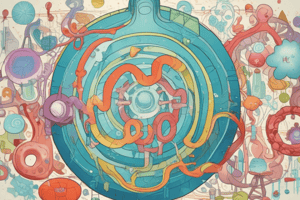Podcast
Questions and Answers
Where does oxidative deamination primarily take place?
Where does oxidative deamination primarily take place?
- Liver and kidney (correct)
- Muscles and pancreas
- Lungs and stomach
- Brain and heart
What is the main reason for oxidative deamination?
What is the main reason for oxidative deamination?
- To synthesize glucose
- To provide NH3 for urea synthesis (correct)
- To produce amino acids
- To generate energy for the body
What is another outcome of oxidative deamination?
What is another outcome of oxidative deamination?
- Production of fatty acids
- Synthesis of cholesterol
- Generation of ATP
- Formation of α-keto acids (correct)
What is the role of α-keto acids in the body?
What is the role of α-keto acids in the body?
What is the byproduct of oxidative deamination that is used for energy generation?
What is the byproduct of oxidative deamination that is used for energy generation?
What is the significance of urea synthesis in the context of oxidative deamination?
What is the significance of urea synthesis in the context of oxidative deamination?
What is the purpose of transamination in the context of amino acid metabolism?
What is the purpose of transamination in the context of amino acid metabolism?
What is the result of transamination in terms of nitrogen concentration?
What is the result of transamination in terms of nitrogen concentration?
What are the two types of processes involved in amino acid metabolism?
What are the two types of processes involved in amino acid metabolism?
What is the role of transamination in managing excess amino acids?
What is the role of transamination in managing excess amino acids?
What is the overall goal of amino acid metabolism?
What is the overall goal of amino acid metabolism?
What is the typical range of amino acids found in proteins?
What is the typical range of amino acids found in proteins?
What is a characteristic feature of amino acids?
What is a characteristic feature of amino acids?
What is the role of a-ketoglutarate in transamination reactions?
What is the role of a-ketoglutarate in transamination reactions?
What determines the sequence of amino acids in a protein?
What determines the sequence of amino acids in a protein?
What is the product of the transamination reaction catalyzed by aminotransferases?
What is the product of the transamination reaction catalyzed by aminotransferases?
Where are aminotransferases active?
Where are aminotransferases active?
What is the classification of a chain of 3 amino acids?
What is the classification of a chain of 3 amino acids?
What elements make up an amino acid?
What elements make up an amino acid?
What is the function of the PLP cofactor in transamination reactions?
What is the function of the PLP cofactor in transamination reactions?
What is the general structure of an amino acid, as shown in the diagram?
What is the general structure of an amino acid, as shown in the diagram?
Flashcards are hidden until you start studying
Study Notes
Amino Acids
- Amino acids are organic acids that contain an NH2 group.
- They are composed of carbon, hydrogen, oxygen, and nitrogen.
- Chains of amino acids are classified as:
- Peptides: fewer than 50 amino acids
- Dipeptides: 2 amino acids
- Tripeptides: 3 amino acids
- Polypeptides: more than 10 amino acids
- Proteins: more than 50 amino acids (typically 100 to 10,000 amino acids linked together)
Transamination
- Transamination is the reversible transfer of an amino group (in the form of ammonia) from an α-amino acid to an α-keto acid.
- It forms a new amino acid and a new α-keto acid.
- This process occurs mostly in the liver and kidney.
- Transamination involves both catabolism (degradation) and anabolism (synthesis) of amino acids.
- It diverts excess amino acids towards energy generation.
- The amino acids undergo transamination to finally concentrate nitrogen in glutamate.
Metabolism of Amino Acids
- Amino acids undergo certain common reactions, including transamination followed by deamination for the liberation of ammonia.
- This process is involved in the production of non-essential amino acids.
- The purpose of oxidative deamination is to provide NH3 for urea synthesis and α-keto acids for a variety of reactions, including energy generation.
Aminotransferases
- Aminotransferases are active both in the cytoplasm and mitochondria.
- They catalyze transamination reactions, where α-ketoglutarate acts as an amino group acceptor.
- The reaction involves the transfer of an amino group from an amino acid to an α-keto acid, resulting in a new amino acid and a new keto acid.
Studying That Suits You
Use AI to generate personalized quizzes and flashcards to suit your learning preferences.





